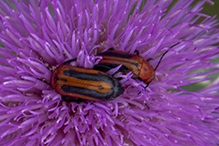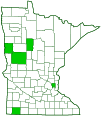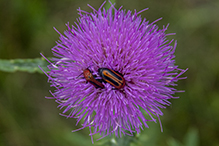orange blister beetle
(Nemognatha piazata)
Conservation • Description • Habitat • Ecology • Distribution • Taxonomy
|
|
|||||||||||||
Description |
Orange blister beetle is a small to medium-sized beetle. It occurs in the United States, southern Canada, and northern Mexico. There are three geographically separated subspecies. The nominate subspecies, Nemognatha piazata piazata, is restricted to the southeast. It is most common in Florida, but the range extends into Alabama, Georgia, and North Carolina. Nemognatha piazata palliata has a narrow range extending from southern Minnesota to Arkansas. Nemognatha piazata bicolor is the most widespread subspecies. Its range extends from Minnesota south to Texas and west to Washington and Arizona. Where the ranges of N. p. bicolor and N. p. palliata overlap in Minnesota, the species intergrade, and some individuals have intermediate characteristics. Orange blister beetle adults feed on nectar and pollen of plants in the Aster (Asteraceae) family, especially thistles in the genera Cirsium and Carduus, but also on Rudbeckia. They are active from April to August in the south, but in Minnesota, all records are from July. The larvae are parasites in the nests of bees. They feed on the hosts’ larvae, stored pollen, and honey. Adults are ¼″ to ⅝″ (7 to 15 mm) in length. The body is rather robust, almost cylindrical. It is orange with a highly variable amount of black. The surface is somewhat shiny. The head is triangular, much wider than long, and strongly narrowed to the eyes. It is usually entirely orange, sometimes with some black or almost entirely black. The eyes are moderately large. The antennae are thread-like and have 11 segments. The ends of the antennae are not enlarged (clubbed). The “under jaws” (maxillae) are extended into a long to very long, filament-like, sucking tube. The plate covering the first segment of the thorax (pronotum) is wider than long. It is widest at the front angles, which are broadly rounded, then very slightly narrowed to the rear angles, which are abruptly rounded. It is shallowly and evenly pitted (punctate), and there is a single, short, leaning, dark hair (seta) rising from each puncture. There is sometimes a shallow longitudinal groove on the basal third. The plate between the wing bases (scutellum) is large for a blister beetle. It is triangular, rounded at the tip, and shallowly depressed in the middle. The surface is densely punctate and covered with fine hairs. The wing covers (elytra) are long, entirely covering the abdomen. The color varies from entirely orange, to orange with a broad, black stripe from the base to the tip of each elytron, to entirely black. The surface is densely and finely punctate, and is densely covered with short, dark setae. The legs are moderately long, densely punctate, and densely hairy. At the tip of the fourth leg segment (tibia) there is a pair of spurs at the tip. The last part of each leg (tarsus), corresponding to the foot, is black. The tarsi on the front and middle legs each have five segments, while those on the hind legs have only four segments. There is a pair of claws at the end of each tarsus. The claws on all legs are comb-like, with two rows of fine teeth.
Nemognatha piazata bicolor The maxillary filaments are long, but they do not reach to the tip of the abdomen. They often do not extend beyond the second abdominal segment. The head and pronotum are entirely orange. The pronotum is distinctly wider than the head. There is no median groove on the pronotum. On the hind tibia, the spurs are short, almost equal in size and shape, and are slightly concave at the tip. Adults have been recorded on flowers in the genera Cirsium, Carduus, and Grindelia.
Nemognatha piazata palliata The maxillary filaments are very long, reaching to the tip or almost to the tip of the abdomen. The pronotum is distinctly wider than the head. There is no median groove on the pronotum. On the hind tibia, the inner spur is shorter, narrower, and more spine-like than the outer. Adults have been recorded on flowers in the genus Rudbeckia. |
Size |
Total length: ¼″ to ⅝″ (7 to 15 mm) |
Similar Species |
Habitat |
|
Ecology |
Season |
Spring and summer |
Behavior |
|
Life Cycle |
The female lays a cluster of eggs on the floral bracts (phyllaries) of thistle flowers. When the eggs hatch, the larvae climb to the floral disk and attempt to attach themselves to any moving object. If successful, and if that object is a female bee, the larva is carried back to the bee’s nest. In the nest, the larva remains inactive until the cell that it finds itself in is sealed. It then consumes the bee egg, and later feeds on the stored pollen and honey in the cell. |
Larva Food |
Bee larvae, stored pollen, and honey |
Adult Food |
Nectar and pollen of plants in the Aster (Asteraceae) family, especially thistles |
Distribution |
||
|
Sources A revision of the genera Nemognatha, Zonitis, and Pseudozonitis (Coleoptera, Meloidae) in America north of Mexico, with.... Enns, W.R. 1956. University of Kansas Scientific Bulletin 37(17): 685-909. |
|
| 2/28/2024 | ||
Occurrence |
||
|
||
Taxonomy |
|
Order |
Coleoptera (Beetles) |
Suborder |
Polyphaga (Water, Rove, Scarab, Long-horned, Leaf, and Snout Beetles) |
Infraorder |
Cucujiformia |
Superfamily |
Tenebrionoidea (darkling beetles and allies) |
Family |
Meloidae (blister beetles) |
Subfamily |
Nemognathinae |
Tribe |
Nemognathini |
Genus |
Nemognatha |
Subgenus |
Nemognatha |
This species was formerly placed in the genus Zonitis. In 1952 it was moved to the genus Nemognatha. |
|
Subordinate Taxa |
|
orange blister beetle (Nemognatha piazata bicolor) orange blister beetle (Nemognatha piazata palliata) orange blister beetle (Nemognatha piazata piazata) |
|
The three subspecies were originally treated as full species. |
|
Synonyms |
|
Zonitis piazata |
|
Common Names |
|
orange blister beetle |
|
Glossary
Elytra
The hardened or leathery forewings of beetles used to protect the fragile hindwings, which are used for flying. Singular: elytron.
Maxillae
Paired mouth structures of arthropods located immediately behind the mandible and used for tasting and manipulating food. “Under-jaws”.
Pronotum
The exoskeletal plate on the upper side of the first segment of the thorax of an insect.
Prothorax
The first (forward) segment of the thorax on an insect, bearing the first pair of legs but not wings.
Punctate
Dotted with pits (punctures), translucent sunken glands, or colored spots of pigment.
Scutellum
The exoskeletal plate covering the rearward (posterior) part of the middle segment of the thorax in some insects. In Coleoptera, Hemiptera, and Homoptera, the dorsal, often triangular plate behind the pronotum and between the bases of the front wings. In Diptera, the exoskeletal plate between the abdomen and the thorax.
Seta
A stiff, hair-like process on the outer surface of an organism. In Lepidoptera: A usually rigid bristle- or hair-like outgrowth used to sense touch. In mosses: The stalk supporting a spore-bearing capsule and supplying it with nutrients. Plural: setae. Adjective: setose.
Tarsus
On insects, the last two to five subdivisions of the leg, attached to the tibia; the foot. On spiders, the last segment of the leg. Plural: tarsi.
Tibia
The fourth segment of an insect leg, after the femur and before the tarsus (foot). The fifth segment of a spider leg or palp. Plural: tibiae.
Visitor Photos |
||
Share your photo of this insect. |
||
This button not working for you? |
||
|
||
|
||
MinnesotaSeasons.com Photos |
||
 |

Slideshows |
|

Visitor Videos |
||
Share your video of this insect. |
||
This button not working for you? |
||
|
Other Videos |
||
|

Visitor Sightings |
||
Report a sighting of this insect. |
||
This button not working for you? |
||
|
|
MinnesotaSeasons.com Sightings |
||

Created: 2/29/2024 Last Updated: © MinnesotaSeasons.com. All rights reserved. |

